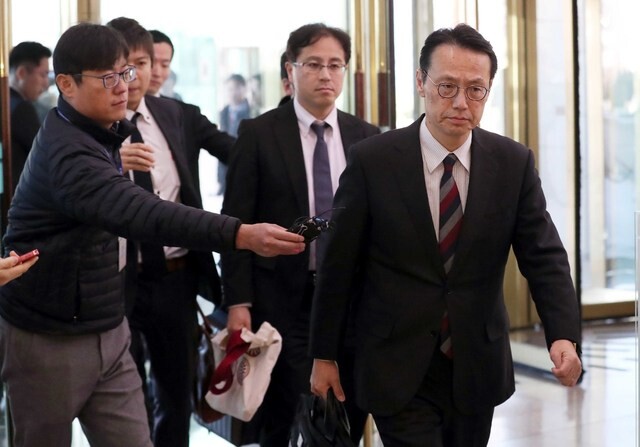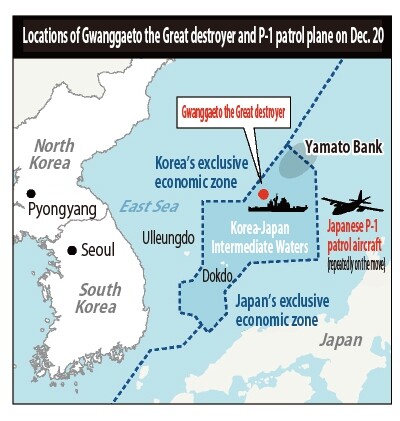hankyoreh
Links to other country sites 다른 나라 사이트 링크
S. Korea and Japan unable to reach agreement on compensation for forced labor victims

South Korean and Japanese government officials were reportedly unable to bridge their differences on Dec. 24 in their first round of discussions regarding a South Korean Supreme Court ruling ordering compensation to victims of forced conscription during the Japanese occupation.
Representatives of the victims announced plans to initiate compulsory execution procedures to seize Nippon Steel and Sumitomo Metal assets in South Korea, while calling on the company to quickly begin discussions.
In a meeting lasting around 90 minutes that afternoon at the Ministry of Foreign Affairs (MOFA) building in Seoul’s Doryeom neighborhood, MOFA’s Northeast Asia Bureau Chief Kim Yong-gil and Asia-Oceania Bureau Chief Kenji Kanasugi of the Japanese Foreign Ministry discussed major issues in bilateral relations, including the court ruling on compensation for forced conscription.
“Our respective governments explained their positions on the matter of the forced conscription ruling, and we agreed that there should be close communication between diplomatic authorities to resolve the issue while minimizing the impact on South Korea-Japan relations,” Kim explained after the meeting.
According to a report by the NHK network, Japan reiterated its previous position during the meeting, arguing that the matter of compensation for forced conscription was resolved by the two sides’ Claims Settlement Agreement in 1965.
“We insist on the importance of the South Korean government putting forward a response plan as quickly as possible,” Kanasugi was quoted as saying in the meeting.
“The South Korean government is currently weighing [response measures], so we plan to watch and see what happens,” he added.
Sungkonghoe University professor Yang Ki-ho said Japan “appears to have suggested the discussions on Dec. 24 with the aim of urging the South Korean government to come up with a response plan quickly due to concerns about the seizure of the Japanese company’s assets.”
“Japan is insisting that the South Korean government compensate the victims on the Japanese company’s behalf, but that’s an impossible demand,” Yang added.
In a position statement the same day, legal representatives of the victims said, “While we asked Nippon Steel on Dec. 4 to participate in discussions on compensation by 5 pm on Dec. 24, Nippon Steel has yet to state its willingness to participate in discussions.”
“We therefore plan to initiate procedures immediately for the seizure of Nippon Steel’s assets within South Korea,” they announced.
At the same time, they added, “Because discussions between South Korean and Japanese authorities are still ongoing, we will take the situation with diplomatic negotiations into account as we decide on the date of execution.”
“We still hope to resolve the issue through discussions with Nippon Steel,” they said.
When asked whether the Japanese side had expressed a position on the possibility of an asset seizure during the Dec. 24 meeting, a MOFA senior official said, “Opinions were shared extensively on various issues.”
Discussions on S. Korean navy radar locking on to Japanese patrol plane

Discussions also took place during the meeting on a recent incident in which the South Korean navy vessel locked its targeting radar on a Japan Self-Defense Forces patrol aircraft flying over the East Sea on Dec. 20. The two sides reportedly expressed differences on the issue.
“We held discussions between foreign affairs authorities with an official from the South Korean Ministry of National Defense and a defense officer from the Japanese embassy in attendance, and both sides explained their respective positions in detail,” Kim said.
A MOFA official explained that the South Korean side “expressed strong dismay at Japan having disclosed its position to the press without a definite confirmation of the facts.”
Kanasugi also reiterated Japan’s message of “dismay” over the South Korean destroyer’s radar being aimed at the Japanese patrol aircraft and strongly urged measures to “prevent similar incidents from occurring.”
By Park Min-hee and Ko Han-sol, staff reporters, and Cho Ki-weon, Tokyo correspondent
Please direct comments or questions to [english@hani.co.kr]

Editorial・opinion
![[Column] Park Geun-hye déjà vu in Yoon Suk-yeol [Column] Park Geun-hye déjà vu in Yoon Suk-yeol](https://flexible.img.hani.co.kr/flexible/normal/500/300/imgdb/original/2024/0424/651713945113788.jpg) [Column] Park Geun-hye déjà vu in Yoon Suk-yeol
[Column] Park Geun-hye déjà vu in Yoon Suk-yeol![[Editorial] New weight of N. Korea’s nuclear threats makes dialogue all the more urgent [Editorial] New weight of N. Korea’s nuclear threats makes dialogue all the more urgent](https://flexible.img.hani.co.kr/flexible/normal/500/300/imgdb/original/2024/0424/7317139454662664.jpg) [Editorial] New weight of N. Korea’s nuclear threats makes dialogue all the more urgent
[Editorial] New weight of N. Korea’s nuclear threats makes dialogue all the more urgent- [Guest essay] The real reason Korea’s new right wants to dub Rhee a founding father
- [Column] ‘Choson’: Is it time we start referring to N. Korea in its own terms?
- [Editorial] Japan’s rewriting of history with Korea has gone too far
- [Column] The president’s questionable capacity for dialogue
- [Column] Are chaebol firms just pizza pies for families to divvy up as they please?
- [Column] Has Korea, too, crossed the Rubicon on China?
- [Correspondent’s column] In Japan’s alliance with US, echoes of its past alliances with UK
- [Editorial] Does Yoon think the Korean public is wrong?
Most viewed articles
- 1‘We must say no’: Seoul defense chief on Korean, USFK involvement in hypothetical Taiwan crisis
- 2Will NewJeans end up collateral damage in internal feud at K-pop juggernaut Hybe?
- 3[Column] Park Geun-hye déjà vu in Yoon Suk-yeol
- 4Why Korea shouldn’t welcome Japan’s newly beefed up defense cooperation with US
- 5Thursday to mark start of resignations by senior doctors amid standoff with government
- 6N. Korean hackers breached 10 defense contractors in South for months, police say
- 7[Guest essay] The real reason Korea’s new right wants to dub Rhee a founding father
- 8[Column] ‘Choson’: Is it time we start referring to N. Korea in its own terms?
- 9Kim Jong-un expressed ‘satisfaction’ with nuclear counterstrike drill directed at South
- 10[Editorial] New weight of N. Korea’s nuclear threats makes dialogue all the more urgent